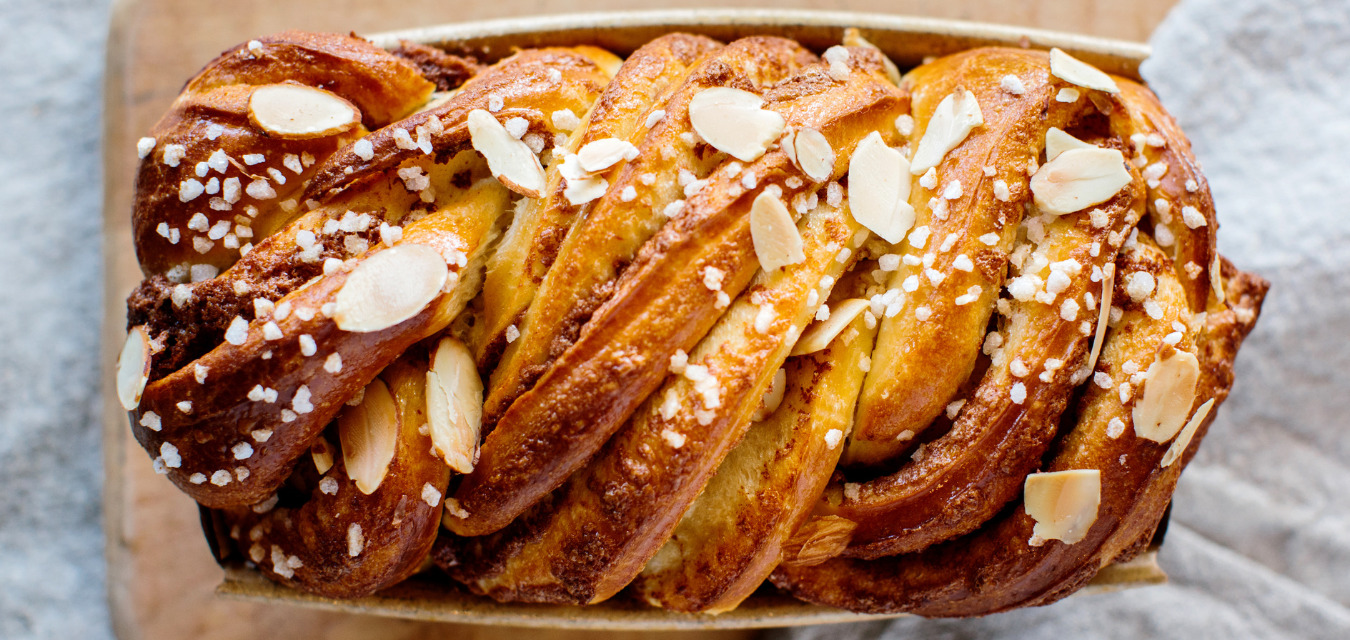recipe 
yields
Makes 2 loaves
1 teaspoon cinnamon
⅓ cup plus 2 tablespoons sugar
3½ cups bread flour
2 teaspoons instant yeast
1½ teaspoons fine sea salt, plus more for egg wash
½ cup unsalted butter, cold
1 cup whole milk, at room temperature
2 large eggs, at room temperature and beaten, plus 1 egg for egg wash
2 teaspoons pearl sugar
2 teaspoons blanched sliced almonds
Instant-read thermometer
Ingredients
Special equipment:
steps
- In a small bowl, combine cinnamon and 2 tablespoons of the sugar. Set aside. To a medium bowl, add flour, yeast, and salt. Combine and set aside. Soften cold butter by beating with a rolling pin until malleable—it should be soft, but not oily. In another bowl, combine milk and beaten eggs and mix well. Using an instant-read thermometer, measure temperature of milk; it should read between 75 and 80 degrees.
- To the bowl of a stand mixer fitted with dough hook attachment, add half the milk mixture, then add flour mixture. (Adding some liquid first keeps dry ingredients from sticking to the bottom of the bowl.) Mix on low speed, gradually adding remaining milk mixture until a soft, shaggy dough forms. (Be careful not to add milk too late, as it becomes difficult to incorporate once dough has formed.) Stop mixer often to scrape hook and sides of bowl with a rubber spatula.
- Once dough has formed, mix on low speed for 5 minutes. Sprinkle in a third of the remaining sugar. Begin mixing again on medium-low speed and, over the course of 5 minutes, add remaining sugar in two batches. After 5 minutes on medium-low speed, add softened butter, a few tablespoons at a time, mixing until butter is incorporated and dough is smooth. This should take about 5 minutes. Turn dough onto a lightly floured surface. Using thermometer, check temperature of dough: it should be between 72 and 80 degrees. (If it’s higher than 80 degrees, refrigerate dough in 15-minute increments until it falls into the proper temperature range. If it’s lower, adjust time of fermentation in next step.)
- Shape dough into a ball by pulling one edge to the center and pressing lightly; turn dough one quarter and repeat folding process three more times (do not add additional flour to folds during this process). Lightly dust the inside of a large glass or metal bowl with flour and transfer dough to bowl, smooth side up. Cover bowl loosely with plastic wrap—the plastic should not touch the dough. If it does, very lightly dust top of dough with flour to prevent plastic from sticking. Let dough sit in a draft-free place that’s around 70 degrees for about 45 minutes. If the dough’s temperature was lower than 72 degrees after mixing, let it ferment an additional 10 minutes for every 2 degrees below 72. Then, repeat folding process and ferment an additional 45 minutes. Place dough in refrigerator for 3 hours.
- Place chilled dough on a lightly floured surface, divide in half, and flatten each half to a 4×9-inch rectangle, the length of a standard loaf pan. Set one half aside. Sprinkle remaining dough with half the cinnamon sugar mixture, then roll long edge of dough so you’re left with a 9-inch-long log. Cut log lengthwise and lay strands side-by-side. Beginning in the middle, overlap top and bottom halves so it has a “braided” look, then pick up dough in both hands and twist it slightly before placing in a greased loaf pan. Repeat process with second portion of dough and place in a second loaf pan. Beat remaining egg with a pinch of salt; brush egg wash over loaves. Keep remaining egg wash in refrigerator.
- Move dough to a draft-free place for 2 to 3 hours–but keep a close eye on it as you cannot fix dough that is over-proofed (meaning it was allowed to sit too long). To test if it’s ready to bake, gently press a finger into dough to make a small indentation. If the indentation slowly disappears, it’s ready to bake. If it quickly bounces back, let the dough ferment another 20 minutes and check again. If it quickly bounces back again, wait another 10 minutes. If after a total of 30 minutes, the indentation still disappears quickly, check at 5-minute intervals. (If indentation causes entire dough to deflate, it is over-proofed; the interior texture and flavor will be off when baked.)
- Meanwhile, preheat oven to 400 degrees and position a rack just below the center. Once dough is ready, brush with remaining egg wash, sprinkle with 2 teaspoons each of pearl sugar and sliced almonds, and bake until the loaves are a deep golden brown, 25 minutes. Let cool completely on a wire rack.
From The Rise of La Farm.
Date Published: 05.01.20
share
-
Recipe By
Lionel Vatinet, La Farm Bakery, Cary, North Carolina -
Contributing City
Raleigh






